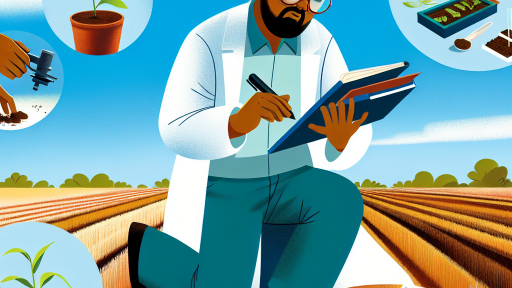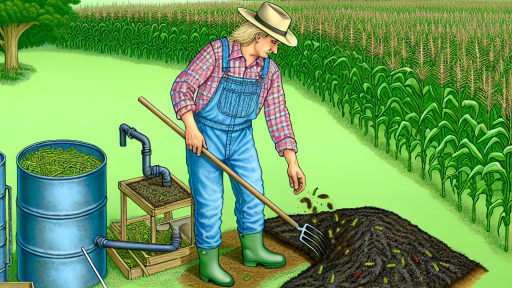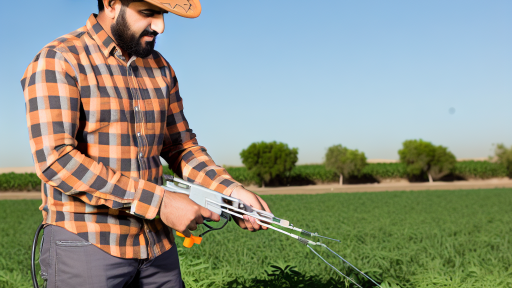Introduction to Crop Sequences and Their Importance for Sustainability
Crop sequences play a vital role in sustainable agriculture.
They involve rotating different crops in a systematic manner.
This practice maximizes soil health and reduces pest outbreaks.
Additionally, crop sequences enhance biodiversity on the farm.
Farmers grow diverse crops, which provides habitats for various organisms.
Moreover, diverse planting strategies improve soil structure and fertility.
They minimize the reliance on chemical fertilizers and pesticides.
Transitioning between crops helps disrupt pest and disease cycles.
Consequently, farmers can achieve healthier yields over time.
Crop sequences contribute to better nutrient cycling within the soil.
This approach reduces soil erosion and promotes water retention.
Ultimately, sustainable crop sequences lead to long-term farm viability.
The knowledge gained from previous crop performance can inform future decisions.
Farmers can also utilize local resources and adapt to climate changes.
In summary, planning diverse crop sequences is essential for sustainability.
Transform Your Agribusiness
Unlock your farm's potential with expert advice tailored to your needs. Get actionable steps that drive real results.
Get StartedThese practices not only benefit farmers but also the environment.
Benefits of Diverse Crop Sequences for Soil Health and Fertility
Enhancing Soil Structure
Diverse crop sequences improve soil structure significantly.
Different root systems penetrate various soil layers effectively.
This penetration helps alleviate compaction and promotes aeration.
As a result, soil becomes more conducive to water infiltration.
Consequently, healthier soil leads to improved root growth for all plants.
Increasing Nutrient Availability
Diverse crops help to balance nutrient uptake in the soil.
Leguminous plants, for example, enhance nitrogen availability.
They fix atmospheric nitrogen, enriching the soil naturally.
Diverse rotations can also prevent nutrient depletion.
Consequently, this reduces the need for synthetic fertilizers.
Suppressing Pests and Diseases
Diverse crop sequences can disrupt pest life cycles effectively.
Many pests thrive on specific crops, so rotation helps manage them.
Diversity reduces the buildup of pathogens in the soil.
As a result, crops become healthier and more resilient.
This natural pest suppression minimizes pesticide use significantly.
Promoting Soil Microbial Diversity
Crop diversity fosters a rich community of soil microbes.
Different plants attract various beneficial organisms.
These organisms improve nutrient cycling and organic matter decomposition.
Furthermore, increased microbial diversity enhances soil health.
This contributes to more robust crop growth and fertility.
Increasing Resilience to Environmental Stress
Diverse crop rotations build resilience to climate variability.
Different crops respond uniquely to environmental stresses.
This variability allows farmers to adapt to changing conditions.
Showcase Your Farming Business
Publish your professional farming services profile on our blog for a one-time fee of $200 and reach a dedicated audience of farmers and agribusiness owners.
Publish Your ProfileAs a result, farmers can mitigate risks associated with droughts or floods.
Ultimately, this resilience promotes sustainable agricultural practices.
Factors to Consider When Planning Crop Sequences
Understanding Climate Conditions
Agricultural planning starts with understanding the local climate.
This includes factors like temperature and rainfall patterns.
Climate directly impacts crop selection and timing.
Farmers should monitor seasonal changes regularly.
Additionally, they must consider extreme weather events.
Evaluating Soil Type
The type of soil plays a crucial role in crop success.
Different crops thrive in specific soil conditions.
Farmers should conduct soil tests for nutrient levels.
Soil texture affects water retention and drainage capabilities.
Understanding soil pH can also enhance crop performance.
Analyzing Market Demand
Market demand influences which crops should be planted.
Farmers should research current and projected market trends.
Understanding consumer preferences helps guide decisions.
Additionally, seasonal variations can affect demand patterns.
Farmers may also consider local versus export markets.
Incorporating Crop Rotation Principles
Crop rotation enhances soil health and pest management.
Different crops contribute varying nutrients to the soil.
Rotating crops can disrupt pest and disease cycles.
Farmers should plan rotations based on crop families.
This promotes biodiversity and reduces the need for fertilizers.
Implementing Sustainable Practices
Sustainable practices are essential for long-term productivity.
Using cover crops improves soil structure and prevents erosion.
Organic amendments enhance soil fertility naturally.
Farmers should integrate eco-friendly pest control methods.
These practices also help meet consumer demand for sustainability.
See Related Content: Cover Crops For Soil Regeneration Strategies
Strategies for Integrating Legumes into Crop Sequences for Nitrogen Fixation
Understanding Nitrogen Fixation
Nitrogen fixation is a crucial process for enhancing soil fertility.
Legumes, such as peas and beans, play a vital role in this process.
They convert atmospheric nitrogen into a form usable by plants.
This contributes significantly to sustainable agriculture practices.
Choosing the Right Legumes
Selecting the appropriate legumes is essential for effective nitrogen fixation.
Consider climatic conditions and soil types in your region.
Common choices include clover, alfalfa, and soybeans.
Each species has unique benefits for different environments.
Crop Rotation Practices
Implementing crop rotation is an effective strategy.
Introduce legumes in rotation with cereal crops.
For example, follow wheat with a legume crop like lentils.
This approach enhances nitrogen availability for subsequent crops.
Showcase Your Farming Business
Publish your professional farming services profile on our blog for a one-time fee of $200 and reach a dedicated audience of farmers and agribusiness owners.
Publish Your ProfileIntercropping Techniques
Intercropping can maximize land use and nutrient cycling.
Plant legumes alongside other crops for mutual benefits.
For instance, pairing maize with beans improves overall yield.
This technique promotes biodiversity and pest control.
Incorporating Cover Crops
Utilizing cover crops can enhance soil health.
Plant legumes as cover crops during the off-season.
They prevent soil erosion and suppress weeds effectively.
Furthermore, cover crops improve soil structure and moisture retention.
Monitoring Soil Health
Regular soil testing is important for assessing nutrient levels.
Evaluate the impact of legumes on soil fertility over time.
This helps in adjusting management practices as needed.
Take note of any changes in soil organic matter and pH levels.
Engaging with Local Agricultural Experts
Seek advice from local agricultural extensions or experts.
They can provide region-specific recommendations for legume integration.
Collaboration with local researchers can lead to innovative practices.
Engagement within the community fosters knowledge sharing and support.
See Related Content: Native Plant Integration in Agricultural Systems
Case Studies of Successful Diverse Crop Sequences Around the World
Diverse Crop Sequences in Peru
In the highlands of Peru, farmers practice diverse crop sequences with potatoes and quinoa.
This method improves soil fertility while reducing pests and diseases.
The integration of legumes enhances nitrogen levels, benefiting subsequent crops.
Furthermore, farmers can achieve higher yields compared to monoculture systems.
Crop Rotation in the Netherlands
In the Netherlands, innovative crop rotation practices significantly boost sustainable farming.
Farmers alternate between cereals, vegetables, and cover crops to maintain soil health.
This approach also reduces reliance on chemical fertilizers.
Consequently, the overall resilience of the agricultural system improves over time.
Agroforestry in Kenya
Kenyan farmers incorporate agroforestry into their diverse crop sequences.
They plant maize alongside trees like Grevillea robusta for shade and protection.
This system enhances biodiversity while improving crop yields and resilience.
Moreover, tree roots help prevent soil erosion during heavy rains.
Polyculture in Southeast Asia
Southeast Asian farmers utilize polyculture techniques to enhance productivity.
They grow rice in combination with fish farming, creating a mutually beneficial ecosystem.
This integration ensures both crops and fish thrive in a sustainable environment.
Additionally, farmers report higher income due to diversified products.
Cover Cropping in the United States
In the U.S., cover cropping has gained popularity among sustainable farmers.
Farmers plant cover crops during the off-season to improve soil structure and fertility.
This practice reduces erosion while enhancing moisture retention in the soil.
As a result, main crops benefit from healthier growing conditions in the spring.
Intercropping in China
Intercropping is a common practice among Chinese farmers, especially with rice and soybeans.
This method boosts land productivity and diversifies the farmer’s harvest.
Additionally, it requires fewer pesticides, promoting a healthier food system.
Showcase Your Farming Business
Publish your professional farming services profile on our blog for a one-time fee of $200 and reach a dedicated audience of farmers and agribusiness owners.
Publish Your ProfileA study showed that intercropping improves overall crop resilience amidst climate change.
Gain More Insights: Soil Testing Methods For Better Farm Yields

Techniques for Implementing Crop Rotation in Small and Large Scale Farming
Understanding Crop Rotation Benefits
Crop rotation enhances soil health and fertility.
It reduces pest and disease cycles effectively.
Additionally, it helps in better nutrient management.
Farmers can improve their overall yields through rotation.
Planning Crop Sequences
Start by identifying the crops suitable for your climate.
Research the nutrient needs of each crop variety.
Next, consider the time required for each crop to mature.
Furthermore, create a timeline to manage planting and harvesting.
Implementing a Rotation Schedule
Develop a rotation plan that incorporates diverse crops.
For instance, mix legumes with heavy feeders like corn.
Incorporate cover crops to improve soil structure during off-seasons.
This approach enhances the resilience of your farming system.
Utilizing Technology for Effective Management
Leverage agricultural software for planning rotations.
These tools can help monitor soil health and crop performance.
Additionally, use mobile applications to track field activities.
Technology can simplify record-keeping for compliance and analysis.
Adapting Techniques for Scale
Small-scale farms can focus on intensive cropping systems.
This involves diversifying crops in smaller plots for maximized output.
Larger farms should consider zoned crop rotations for efficiency.
Utilizing machinery can aid in faster planting and harvesting.
Engaging with Local Agricultural Extensions
Consult local agricultural experts for tailored advice.
They provide resources and insights on best practices.
Network with other farmers to share experiences and challenges.
Continuous learning from local workshops can improve methods.
Learn More: Using Biochar To Enhance Soil Fertility
Risk Management in Crop Sequencing: Dealing with Pests and Diseases
Understanding the Impact of Pests and Diseases
Pests and diseases can significantly reduce crop yields.
Farmers need to be aware of the specific threats to their crops.
Additionally, understanding pest life cycles helps in timing interventions.
Effective management minimizes losses and enhances yields.
Importance of Crop Diversity in Pest Management
Diverse crop sequences disrupt pest life cycles.
This diversity reduces the likelihood of pest outbreaks.
Incorporating different plant families can confuse pests.
Moreover, diverse crops attract beneficial insects that control pests.
Implementing Integrated Pest Management Strategies
Integrated Pest Management (IPM) combines various control methods.
It includes biological, cultural, and chemical practices.
Farmers should monitor pest populations regularly.
This data informs timely and effective pest control actions.
Utilizing Disease-Resistant Varieties
Selecting disease-resistant plant varieties enhances resilience.
Showcase Your Farming Business
Publish your professional farming services profile on our blog for a one-time fee of $200 and reach a dedicated audience of farmers and agribusiness owners.
Publish Your ProfileResistant varieties can withstand specific diseases better than others.
Farmers should choose varieties suited for their local conditions.
Additionally, rotating crops can interrupt disease life cycles.
Monitoring and Early Detection Techniques
Regular field visits allow for early detection of issues.
Farmers can utilize traps and scouting techniques for monitoring.
Digital tools and apps enhance monitoring efficiency.
Quickly identifying problems leads to timely interventions.
Collaborating with Local Agricultural Extensions
Local agricultural extensions provide valuable resources and advice.
Farmers can benefit from workshops and training sessions.
Collaboration fosters knowledge sharing among the farming community.
Furthermore, experts can suggest appropriate pest and disease management practices.
Monitoring and Evaluating the Success of Crop Sequences for Continuous Improvement
Setting Clear Objectives
Establishing clear objectives is crucial for crop sequence success.
Identify what you aim to achieve, such as yield improvements.
Ensure that these goals align with sustainable agriculture principles.
Implementing Data Collection Methods
Utilize various methods for effective data collection.
Soil samples yield valuable information on nutrient levels.
Regular crop monitoring helps assess growth conditions and pest presence.
Incorporate weather data for a comprehensive understanding of environmental impacts.
Analyzing Collected Data
Data analysis reveals valuable trends and patterns.
Use statistical tools to evaluate the performance of each crop sequence.
Compare results against your established objectives.
Identify which sequences produce the best outcomes and why.
Adjusting Practices Based on Findings
Adjust agricultural practices based on analyzed data.
Consider altering crop rotation frequencies or types based on results.
Incorporate feedback loops to inform ongoing adjustments.
Collaborate with agricultural specialists for expert recommendations.
Engaging with the Farming Community
Seek insights from other farmers utilizing diverse crop sequences.
Participate in local agricultural forums and workshops.
Share experiences to foster collective learning and improvement.
Consider forming cooperatives to support collaborative monitoring efforts.
Utilizing Technology for Improvement
Leverage technology to enhance monitoring effectiveness.
Employ precision agriculture tools to analyze crop health.
Drones can provide aerial assessments of field conditions.
Farm management software facilitates data integration and analysis.
Documenting Best Practices and Lessons Learned
Maintain thorough documentation of successful practices.
Record challenges faced and solutions implemented during the growing season.
Use this documentation to guide future crop sequences.
Share findings with peers to encourage wider adoption of effective methods.
Additional Resources
USDA Science and Research Strategy, 2023-2026: Cultivating …
Mastering Crop Rotation: Boost Soil Health and Yields with …
Showcase Your Farming Business
Publish your professional farming services profile on our blog for a one-time fee of $200 and reach a dedicated audience of farmers and agribusiness owners.
Publish Your Profile



